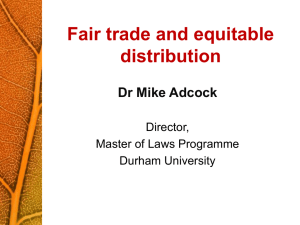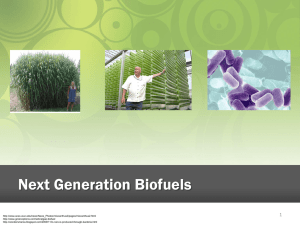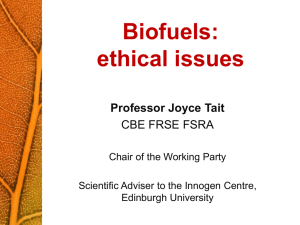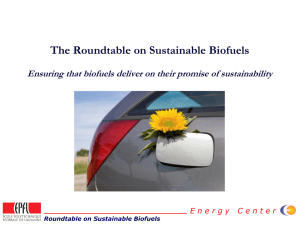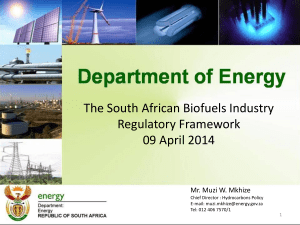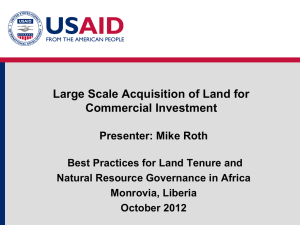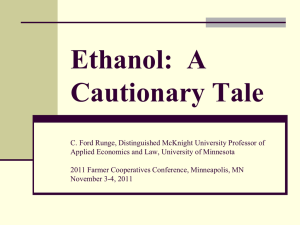Biofuels and Aviation (2)
advertisement
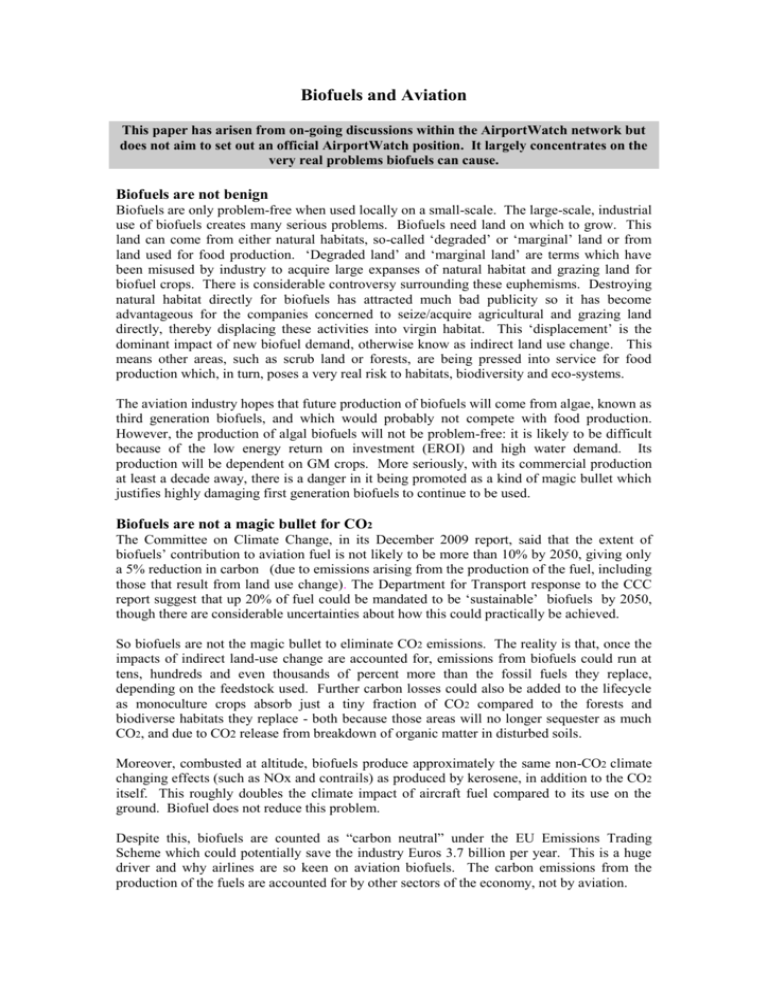
Biofuels and Aviation This paper has arisen from on-going discussions within the AirportWatch network but does not aim to set out an official AirportWatch position. It largely concentrates on the very real problems biofuels can cause. Biofuels are not benign Biofuels are only problem-free when used locally on a small-scale. The large-scale, industrial use of biofuels creates many serious problems. Biofuels need land on which to grow. This land can come from either natural habitats, so-called ‘degraded’ or ‘marginal’ land or from land used for food production. ‘Degraded land’ and ‘marginal land’ are terms which have been misused by industry to acquire large expanses of natural habitat and grazing land for biofuel crops. There is considerable controversy surrounding these euphemisms. Destroying natural habitat directly for biofuels has attracted much bad publicity so it has become advantageous for the companies concerned to seize/acquire agricultural and grazing land directly, thereby displacing these activities into virgin habitat. This ‘displacement’ is the dominant impact of new biofuel demand, otherwise know as indirect land use change. This means other areas, such as scrub land or forests, are being pressed into service for food production which, in turn, poses a very real risk to habitats, biodiversity and eco-systems. The aviation industry hopes that future production of biofuels will come from algae, known as third generation biofuels, and which would probably not compete with food production. However, the production of algal biofuels will not be problem-free: it is likely to be difficult because of the low energy return on investment (EROI) and high water demand. Its production will be dependent on GM crops. More seriously, with its commercial production at least a decade away, there is a danger in it being promoted as a kind of magic bullet which justifies highly damaging first generation biofuels to continue to be used. Biofuels are not a magic bullet for CO2 The Committee on Climate Change, in its December 2009 report, said that the extent of biofuels’ contribution to aviation fuel is not likely to be more than 10% by 2050, giving only a 5% reduction in carbon (due to emissions arising from the production of the fuel, including those that result from land use change). The Department for Transport response to the CCC report suggest that up 20% of fuel could be mandated to be ‘sustainable’ biofuels by 2050, though there are considerable uncertainties about how this could practically be achieved. So biofuels are not the magic bullet to eliminate CO2 emissions. The reality is that, once the impacts of indirect land-use change are accounted for, emissions from biofuels could run at tens, hundreds and even thousands of percent more than the fossil fuels they replace, depending on the feedstock used. Further carbon losses could also be added to the lifecycle as monoculture crops absorb just a tiny fraction of CO2 compared to the forests and biodiverse habitats they replace - both because those areas will no longer sequester as much CO2, and due to CO2 release from breakdown of organic matter in disturbed soils. Moreover, combusted at altitude, biofuels produce approximately the same non-CO2 climate changing effects (such as NOx and contrails) as produced by kerosene, in addition to the CO2 itself. This roughly doubles the climate impact of aircraft fuel compared to its use on the ground. Biofuel does not reduce this problem. Despite this, biofuels are counted as “carbon neutral” under the EU Emissions Trading Scheme which could potentially save the industry Euros 3.7 billion per year. This is a huge driver and why airlines are so keen on aviation biofuels. The carbon emissions from the production of the fuels are accounted for by other sectors of the economy, not by aviation. Biofuels are seen by the aviation industry as a substitute for oil The aviation industry's big problem is its dependence on kerosene. It is under pressure to find an alternative because of the CO2 it emits but, much more so, because of the impact of the end of cheap oil as ‘peak oil’ kicks in. It sees biofuels as the answer. This is particularly true of the US aviation industry; less so, the European industry which believes it can reduce its CO 2 emissions by using biofuels and thereby benefit under the EU Emissions Trading Scheme. In the short term, much of the aviation industry appears to be prepared to use biofuels which it knows are not problem-free, such as palm oil, jatropha and camelina, while pushing for subsidies and grants from Government to research the development of what it calls ‘sustainable’ biofuels such as those produced by algae. Biofuels are profitable for the mega-corporations There is a huge agenda driven by mega-corporations that are now leading the drive into biofuels. Much money can be made from aviation biofuels, and instead of growing biofuels with an intention of reducing climate impacts, they are just being produced as a profitable commodity. The hype has already sparked financial speculation among venture capitalists. In Africa and Mexico speculation is causing land grabs even before government targets and incentives have been agreed. Is the aviation industry a special case? The aviation industry is not uniquely dependent on oil. Road vehicles and trains will not be able to be mainly powered by renewably produced or low carbon electricity for many decades, if at all. Even on an optimistic scenario, not all vehicles will be powered by electricity. But it is true that, biofuels apart, there is no commercial alternative to liquid fuel oils to power aircraft on the horizon. The argument is made that, if biofuels were only used for aircraft, this would limit the social and environmental damage caused by their production. True, but is it realistic for major corporations to invest in biofuels that would only/largely used for aviation? Alternatives need to be explored. While it wouldn’t make sense for research into 3rd generation biofuels to cease, the focus must be on finding other alternatives which don’t have the downsides of biofuels. More fundamentally, the aviation industry, instead of pinning its hopes on biofuels to allow for business-as-usual expansion, needs to think ‘outside the box’ as to what sort of industry it could become in a world of peak oil and accelerating climate change. It needs, for example, to consider whether it mainly concentrates on longer-distance routes where there is no realistic alternative. It should plan for a future where the subsidies it currently enjoys are removed. The danger is the aviation industry’s faith in biofuels will delay or prevent these essential questions being asked.

